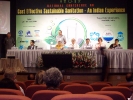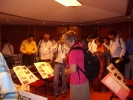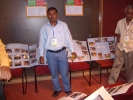C-NES Participation at Conference on Sanitation
A national level conference on ‘Cost Effective Sustainable Sanitation- An Indian Experience’ was held at the India Habitat Centre, New Delhi from 28th to 30th June 2010. Manik Ch. Boruah, Assistant Programme Manager, C- NES participated in the conference and represented C-NES ; the conference was organized by the Water, Sanitation and Hygiene Institute (WASH) in collaboration with Ministry of Rural Development, Plan India, UNICEF, Water Aid, WES- Net India, SPHERE India and Water for People (WEF). Over 250 participants were present from both Government and Civil Society Organizations including professionals, water and sanitation experts, research and technical institutions. Officials from the Urban, Rural and Health ministries (from both Centre and states) and heads of international NGOs were also present.
The objective of the conference –
- To bring key sector players together to share their success stories and approaches in promoting sustainable sanitation and to overcome some of the key challenges.
- To define the strategy to upscale best practices in an efficient and effective manner towards making India an open defecation free nation. The proposed national meet would be a precursor to SACOSAN- IV to be held at Sri Lanka next year.
The conference was inaugurated by the Chief Minister of Delhi Smt. Sheila Dixit while the Executive Director of Plan India, Ms. Bhagyashree Dengle welcomed the gathering. T M Vijay Bhaskar, Joint Secretary, MoRD and Lt. Gen J R Bhardwaj, Member of NDMA, GoI, were also present in the inaugural session and shared their thoughts on a sustainable solution to sanitation in India.
Smt. Sheila Dixhit highlighted the problems of waste- removal in big cities like Delhi. She hoped that adopting the principles of “use, re- use and recycle” could be a good solution for solid waste management. She referred to a project launched by the Delhi government recently to produce power from waste (garbage power) and the Yamuna interceptor scheme under which sludge removal will be under taken to make the river water cleaner. While the job of the municipalities is to ensure that the cities remain clean, educating people about changing their habit is also a key factor in bringing about a change, she mentioned. She requested the Plan and Wash Institute to train municipal engineers in low cost sanitation practices. In her special address, Lizette Burgers, Deputy Country Director, UNICEF, mentioned that 840 million of world’s children lacked access to sanitation facilities and lived in pathetic condition, leading subsequently to diseases like diarrhea as well as malnutrition. In India the figure stood at 140 million. Child mortality will continue to be high if proper sanitation was not ensured. She mentioned that there was some positive developments with 211 million new users of sanitary latrines in India recorded in last 12 years
As many as 45 papers were presented in the conference covering the following themes;
1. Rural sanitation
2. Urban sanitation
3. School sanitation
4. Ecological sanitation
5. Sanitation in emergency response
6. Solid and liquid waste
7. Demand creation through effective hygiene promotion.
In addition to the above, a session was also conducted to review the progress based on the SACOSAN III declaration and the way forward for SACOSAN IV in Sri Lanka next year.
A series of plenary sessions were conducted at the conference. The first session was held at the Stein Auditorium and was addressed by Vijay Mittal, Director, Total Sanitation Campaign (TSC), GoI.. Mr. Mittal mentioned the goal of the ministry- aiming for universal sanitation coverage in rural areas by 2012. Cecilia Ruben, EcoSanRes Programme at Stockholm Environment Institute (SEI) delivered the next address. Speaking on the importance of an enabling environment for policy reform and institution strengthening, she stressed on the importance to protect and promote human health, minimizing environmental degradation and depletion of resource base and also stressed the importance of a technically viable long term sustainable sanitation system.
Kumar Alok, representing the Government of Tripura spoke on his book ‘Squatting with dignity’ on the sanitation movement in India and informed the gathering about Total Sanitation Campaign (TSC) getting a momentum with the announcement of the Nirmal Gram Panchayat Award (launched by the GoI in 2005). He mentioned that TSC is now the fastest growing social sector in India and highlighted the urgent need to change the existing Indian Railway’s lavatory model to prevent human excreta on railway track.
The conference provided a platform for sharing views, research findings and expertise on a wide variety of issues on sanitation and public health with active participation by all present.
The valedictory address was rendered by Christopher Juan Costain, Regional Team Leader WSP- World Bank, Rajashi Mukherjee, Water for People India and . Urvashi Prasad from the Department of Drinking Water Supply.
Relevance to Assam and C-NES:
Taking part in the discussion, Manik Boruah from C-NES Guwahati asked the Joint Secretary, MoRD about the sanitation coverage in the islands of Brahmaputra in Assam under TSC programme as these areas are left out from the benefits of TSC progamme. He also asked if there was any (lavatory) model which could be suitable for flood affected areas. The official accordingly advised him to meet the State Coordinator TSC programme, Assam. The latter was however unable to give a suitable response and asked him to meet the officials of PHE. The Executive Engineer from PHED, Assam, present at the conference replied that there were no separate models designed for flood affected areas, however adding that any SHG or rural group would be supported by the department if they designed models which could be implemented in such areas. He also mentioned that though PHED is trying to cover all villages under the TSC programme, insufficient funds and delay in releasing the same have been major constraints.


